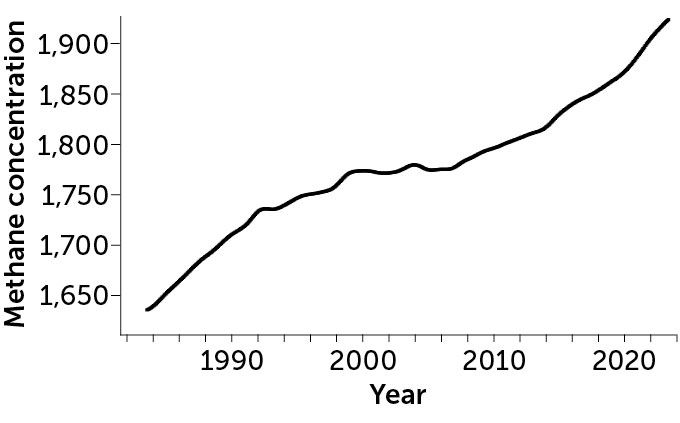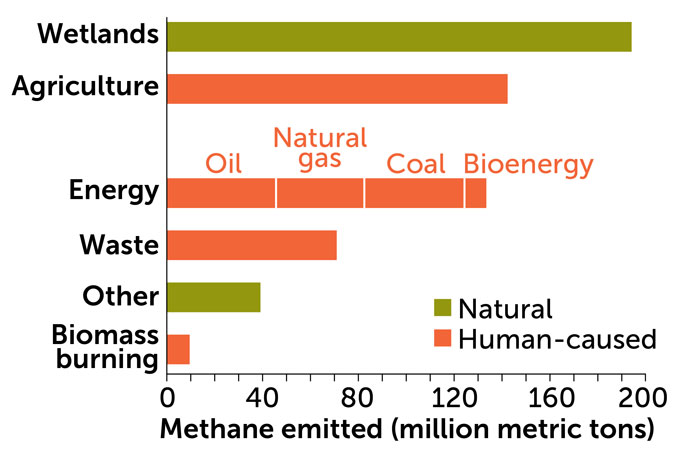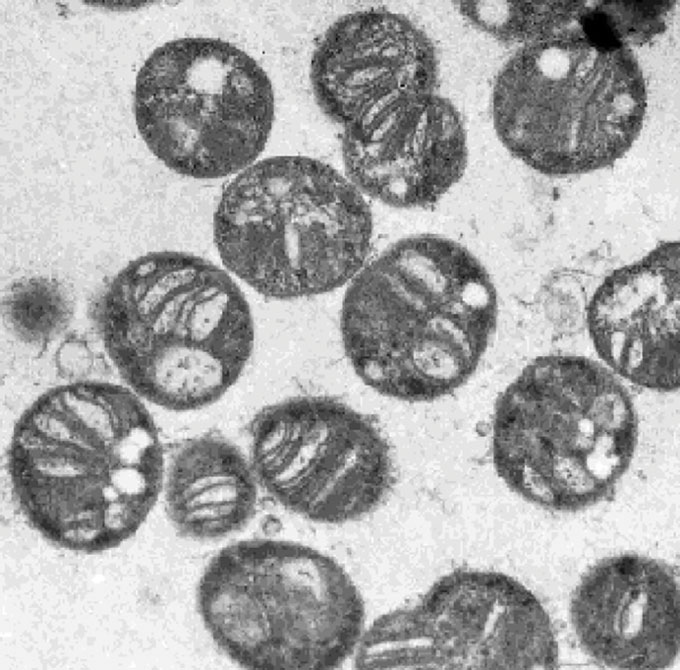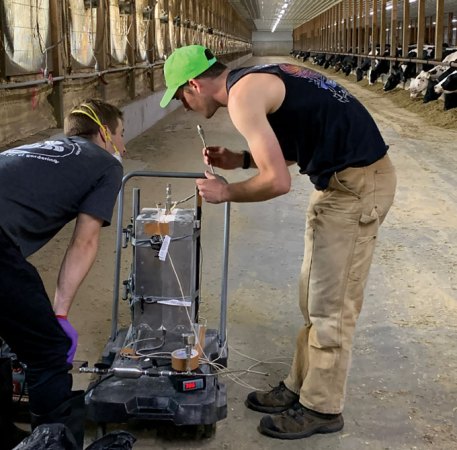Capturing methane from the air would slow global warming. Can it be done?
Methods of removing carbon dioxide from the atmosphere won’t work with methane

Fossil fuel activities, including the flaring of natural gas at oil refineries (shown), release climate-warming methane into the atmosphere.
HHakim/E+/Getty Images Plus
- More than 2 years ago
This summer was the hottest ever recorded on Earth, and 2023 is on track to be the hottest year. Heat waves threatened people’s health across North America, Europe and Asia. Canada had its worst wildfire season ever, and flames devastated the city of Lahaina in Maui. Los Angeles was pounded by an unheard-of summer tropical storm while rains in Libya caused devastating floods that left thousands dead and missing. This extreme weather is a warning sign that we are living in a climate crisis, and a call to action.
Carbon dioxide emissions from burning fossil fuels are the main culprit behind climate change, and scientists say they must be reined in. But there’s another greenhouse gas to deal with: methane. Tackling methane may be the best bet for putting the brakes on rising temperatures in the short term, says Rob Jackson, an Earth systems scientist at Stanford University and chair of the Global Carbon Project, which tracks greenhouse gas emissions. “Methane is the strongest lever we have to slow global warming over the next few decades.”
That’s because it’s relatively short-lived in the atmosphere — methane lasts about 12 years, while CO2 can stick around for hundreds of years. And on a molecule-per-molecule basis, methane is more potent. Over the 20-year period after it’s emitted, methane can warm the atmosphere more than 80 times as much as an equivalent amount of CO2.
We already have strategies for cutting methane emissions — fixing natural gas leaks (methane is the main component of natural gas), phasing out coal (mining operations release methane), eating less meat and dairy (cows burp up lots of methane) and electrifying transportation and appliances. Implementing all existing methane-mitigation strategies could slow global warming by 30 percent over the next decade, research has shown.
But some climate scientists, including Jackson, say we need to go further. Several methane sources will be difficult, if not impossible, to eliminate. That includes some human-caused emissions, such as those produced by rice paddies and cattle farming — though practices do exist to reduce these emissions (SN: 11/28/15, p. 22). Some natural sources are poised to release more methane as the world warms. There are signs that tropical wetlands are already releasing more of the gas into the atmosphere, and rapid warming in the Arctic could turn permafrost into a hot spot for methane-making microbes and release a bomb of methane stored in the currently frozen soil.
So scientists want to develop ways to remove methane directly from the air.
Three billion metric tons more methane exist in the atmosphere today than in preindustrial times. Removing that excess methane would cool the planet by 0.5 degrees Celsius, Jackson says.
On the rise
Over the last 40 years, the concentration of methane in the atmosphere has steadily risen, with a lull in the late 1990s and 2000s. Overall, the amount of methane in the atmosphere has more than doubled over the last 200 years.
Global average methane concentrations, 1983–2023

Similar “negative emissions” strategies are already in limited use for CO2. That gas is captured where it’s emitted, or directly from the air, and then stored somewhere. Methane, however, is a tricky molecule to capture, meaning scientists need different approaches.
Most ideas are still in early research stages. The National Academies of Sciences, Engineering and Medicine is currently studying these potential technologies, their state of readiness and possible risks, and what further research and funding are needed. Some of the approaches include re-engineering bacteria that are already pros at eating methane and developing catalytic reactors to place in coal-mine vents and other methane-rich places to chemically transform the gas.
“Methane is a sprint and CO2 is a marathon,” says Desirée Plata, a civil and environmental engineer at MIT. For scientists focused on removing greenhouse gases, it’s off to the races.
Microbes already remove methane from the air
Methane, CH4, is readily broken down in the atmosphere, where sunshine and highly reactive hydroxyl radicals are abundant. But it’s a different story when chemists try to work with the molecule. Methane’s four carbon-hydrogen bonds are strong and stable. Currently, chemists must expose the gas to extremely high temperatures and pressures to break it down.
Even getting hold of the gas is difficult. Despite its potent warming power, it’s present in low concentrations in the atmosphere. Only 2 out of every 1 million air molecules are methane (by comparison, about 400 of every 1 million air molecules are CO2). So it’s challenging to grab enough methane to store it or efficiently convert it into something else.
Nature’s chemists, however, can take up and transform methane even in these challenging conditions. These microbes, called methanotrophs, use enzymes to eat methane. The natural global uptake of methane by methanotrophs living in soil is about 30 million metric tons per year. Compare that with the roughly 350 million tons of methane that human activities pumped into the atmosphere in 2022, according to the International Energy Agency.
Methane culprits
Experts estimate that in 2022, about 590 million metric tons of methane were released into the atmosphere. About 60 percent of those emissions came from human activities.
Methane emissions in 2022, by source

Microbiologists want to know whether it’s possible to get these bacteria to take up more methane more quickly.
Lisa Stein, a microbiologist at the University of Alberta in Edmonton, Canada, studies the genetics and physiology of these microbes. “We do basic research to understand how they thrive in different environments,” she says.
Methanotrophs work especially slowly in low-oxygen environments, Stein says, like wetland muck and landfills, the kinds of places where methane is plentiful. In these environments, microbes that make methane, called methanogens, generate the gas faster than methanotrophs can gobble it up.
But it might be possible to develop soil amendments and other ecosystem modifications to speed microbial methane uptake, Stein says. She’s also talking with materials scientists about engineering a surface to encourage methanotrophs to grow faster and thus speed up their methane consumption.
Scientists hope to get around this speed bump with a more detailed understanding of the enzyme that helps many methanotrophs feast on methane. Methane monooxygenase, or MMO, grabs the molecule and, with the help of copper embedded in the enzyme, uses oxygen to break methane’s carbon-hydrogen bonds. The enzyme ultimately produces methanol that the microbes then metabolize.
Boosting MMO’s speed could not only help with methane removal but also allow engineers to put methanotrophs to work in industrial systems. Turning methane into methanol would be the first step, followed by several faster reactions, to make an end product like plastic or fuel.

“Methane monooxygenases are not superfast enzymes,” says Amy Rosenzweig, a chemist at Northwestern University in Evanston, Ill. Any reaction involving MMO will impose a speed limit on the proceedings. “That is the key step, and unless you understand it, it’s going to be very difficult to make an engineered organism do what you want,” Rosenzweig says.
Enzymes are often shaped to fit their reactants — in this case, methane — like a glove. So having a clear view of MMO’s physical structure could help researchers tweak the enzyme’s actions. MMO is embedded in a lipid membrane in the cell. To image it, structural biologists have typically started by using detergents to remove the lipids, which inactivates the enzyme and results in an incomplete picture of it and its activity. But Rosenzweig and colleagues recently managed to image the enzyme in this lipid context. This unprecedented view of MMO in its native state, published in 2022 in Science, revealed a previously unseen site where copper binds.
But that’s still not the entire picture. Rosenzweig says she hopes her structural studies, along with other work, will lead to a breakthrough soon enough to help forestall further consequences of global warming. “Maybe people get lucky and engineer a strain quickly,” Rosenzweig says. “You don’t know until you try.”
Chemists make progress on catalysts
Other scientists seek to put methane-destroying chemical reactors close to methane sources. These reactors typically use a catalyst to speed up the chemical reactions that convert methane into a less planet-warming molecule. These catalysts often require high temperatures or other stringent conditions to operate, contain expensive metals like platinum, and don’t work well at the concentrations of methane found in ambient air.
One promising place to start, though, is coal mines. Coal mining is associated with tens of millions of tons of methane emissions worldwide every year. Although coal-fired power plants are being phased out in many countries, coal will be difficult to eliminate entirely due to its key role in steel production, says Plata, of MIT.
To develop a catalyst that might work in a coal mine, Plata found inspiration in MMO. Her team developed a catalyst material based on a silicate material embedded with copper — the same metal found in MMO and much less expensive than those usually required to oxidize methane. The material is also porous, which improves the catalyst’s efficiency because it has a larger surface area, and thus more places for reactions to occur, than a nonporous material would. The catalyst turns methane into CO2, a reaction that releases heat, which is needed to further fuel the reaction. If methane concentrations are high enough, the reaction will be self-sustaining, Plata says.
Turning methane into CO2 may sound counterproductive, but it reduces warming overall because methane traps much more heat than CO2 and is far less abundant in the atmosphere. If all the excess methane in the atmosphere were turned into CO2, according to a 2019 study led by Jackson, it would result in only 8.2 billion additional tons of CO2 — equivalent to just a few months of CO2 emissions at today’s rates. And the net effect would be to lessen the heating of the atmosphere by a sixth.
Cattle feedlots are another place where Plata’s catalytic reactor might work. Barns outfitted with fans to keep cattle comfortable move air around, so reactors could be fitted to these ventilation systems. The next step is determining whether methane concentrations at industrial dairy farms are high enough for the catalyst to work.

Another researcher making progress is energy scientist and engineer Arun Majumdar, one of Jackson’s collaborators at Stanford. In January, Majumdar published initial results describing a catalyst that converts methane into methanol, with an added boost from high-energy ultraviolet light. This UV blast adds the energy needed to overcome CH4’s stubborn bonds — and the carefully designed catalyst stays on target. Previous catalyst designs tended to produce a mix of CO2 and methanol, but this catalyst mostly sticks to making methanol.
Is geoengineering a path to methane removal?
A more extreme approach to speed up methane’s natural breakdown is to change the chemistry of the atmosphere itself. A few companies, such as the U.S.-based Blue Dot Change, have proposed releasing chemicals into the sky to enhance methane oxidation.
Natalie Mahowald, an atmospheric chemist at Cornell University, decided to evaluate this type of geoengineering.
“I’m not super excited about throwing more things into the atmosphere,” Mahowald says. To meet the goals of the Paris Agreement, limiting global warming to 1.5 to 2 degrees Celsius above the preindustrial average, though, it’s worth exploring all possibilities, she says. “If we’re going to meet these targets,” she says “we’re going to need some of these crazy ideas to work. So I’m willing to look at it. But I’m looking with a scientist’s critical eye.”
The main strategy proposed by advocates would inject iron aerosols into the air over the ocean on a sunny day. These aerosols would react with salty sea spray aerosols to form chlorine, which would then attack methane in the atmosphere and initiate further chemical reactions that turn it into CO2. Mahowald wondered how much chlorine would be needed — and if there might be any unintended consequences.
Detailed modeling revealed something alarming. The iron injections could have the opposite of the intended effect, Mahowald and colleagues reported in July in Nature Communications. Chlorine won’t attack methane if ozone is around. Instead, chlorine will first break down all the ozone it can find. But ozone plays a key role in generating the hydroxyl radicals that naturally break down atmospheric methane. So when ozone levels fall, Mahowald says, the concentration and lifetime of methane molecules in the atmosphere actually increases. To use this strategy to break down methane, geoengineers would need to add a tremendous amount of chlorine to the atmosphere — enough to first break down the ozone, then attack methane.
Removing 20 percent of the atmosphere’s methane, thus reducing the planet’s surface temperature by 0.2 degrees Celsius by 2050, for example, would require creating about 630 million tons of atmospheric chlorine every year. That would in turn require injecting perhaps tens of millions of tons of iron. A form of particulate matter, these iron aerosols could worsen air quality; inhaling particulate matter is associated with a range of health problems, particularly cardiovascular and lung disease. This atmospheric tinkering could also create hydrochloric acid that could reach the ocean and acidify it.
And there’s no guarantee that some of the chlorine wouldn’t make it all the way up to the ozone layer, depleting the planetary shield that protects us from the sun’s harmful UV rays. Mahowald is still studying this possibility.
Methane is a sprint and CO2 is a marathon.
Desirée Plata
Mahowald is ambivalent about doing research on geoengineering. “We’re just throwing out ideas here because we’re in a terrible, terrible position,” she says. She’s worried about what could happen if all the methane locked up in the world’s permafrost escapes. If scientists can figure out how to use iron aerosols effectively, without adverse effects — and if such geoengineering is accepted by society — we might need it.
“We’re just trying to see, is there any hope this could work and would we ever want to do it? Would it have enough benefits to outweigh the disadvantages?”
The committee organized by the National Academies to investigate methane removal is taking these kinds of ethical questions into account, as well as considering the potential cost and scale of technologies. Stein, a committee member, says a framework proposed by Spark Climate Solutions provides some guidance. The organization, a nonprofit based in San Francisco that evaluates methane-removal technologies, proposes exploring approaches that can remove tens of millions of tons of methane per year in the coming decades, at a cost of less than $2,000 per ton. Spark cofounder David Mann says the numbers are designed to focus attention and investment on technologies that can make a real difference in curbing climate change in the near term.
The National Academies group aims to make recommendations about research priorities on methane-removal technologies by next summer. It’s likely that a portfolio of different technologies will be necessary. What works in a cattle feedlot may not work at a wastewater treatment plant, for instance.
Scientists focused on methane removal are eager for more researchers, research funding and companies to enter the fray — and quickly. “It’s been a crazy year,” Jackson says of 2023’s extreme weather. We’re already feeling the effects of global warming, but we can seize the moment, he says. “This problem is not something for our grandchildren. It’s here.”







